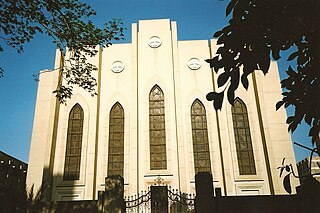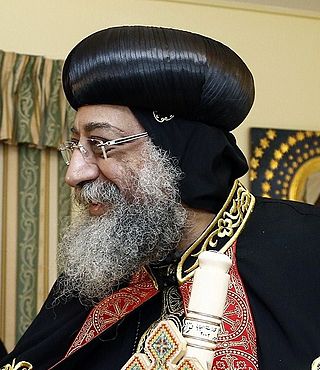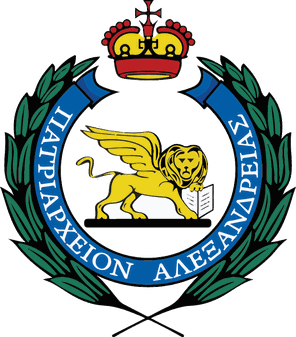
The Coptic Orthodox Church, also known as the Coptic Orthodox Patriarchate of Alexandria, is an Oriental Orthodox Christian church based in Egypt, in Africa and the Middle East. The head of the church and the See of Alexandria is the pope of Alexandria on the Holy Apostolic See of Saint Mark, who also carries the title of Father of fathers, Shepherd of shepherds, Ecumenical Judge and the 13th among the Apostles. The See of Alexandria is titular. The Coptic pope presides from Saint Mark's Coptic Orthodox Cathedral in the Abbassia District in Cairo. The church follows the Coptic Rite for its liturgy, prayer and devotional patrimony. Christians in Egypt total about 10 million people, and Coptic Christians make up Egypt's largest and most significant minority population, and the largest population of Christians in the Middle East and North Africa (MENA).

Cyrenaica or Kyrenaika, is the eastern region of Libya. Cyrenaica includes all of the eastern part of Libya between the 16th and 25th meridians east, including the Kufra District. The coastal region, also known as Pentapolis in antiquity, was part of the Roman province of Crete and Cyrenaica, later divided into Libya Pentapolis and Libya Sicca. During the Islamic period, the area came to be known as Barqa, after the city of Barca.

Pope Shenouda III was the 117th Pope of Alexandria and Patriarch of the See of St. Mark. His papacy lasted 40 years, 4 months, and 4 days, from 14 November 1971 until his death.

The Patriarch of Alexandria is the archbishop of Alexandria, Egypt. Historically, this office has included the designation "pope".

Copts are a Christian ethnoreligious group indigenous to North Africa who have primarily inhabited the area of modern Egypt and Sudan since antiquity. Most ethnic Copts are Coptic Oriental Orthodox Christians. They are the largest Christian denomination in Egypt and the Middle East, as well as in Sudan and Libya. Copts in Egypt account for roughly 5–15 percent of the Egyptian population; Copts in Sudan account for 1 percent of the Sudanese population, while Copts in Libya similarly account for 1 percent of the Libyan population.

The Coptic Catholic Church is an Eastern Catholic particular Church in full communion with the Catholic Church. Along with the Ethiopian Catholic Church and Eritrean Catholic Church, it belongs to the Alexandrian liturgical tradition. Uniquely among the Alexandrian Rite Eastern Catholic liturgies, the Coptic Catholic Church uses the Coptic Rite and the Coptic language in its liturgy; the Ethiopian Catholic Church and Eritrean Catholic Church use the Ge'ez Rite.

The pope, also known as the Bishop of Alexandria or the Coptic pope, is the leader of the Coptic Orthodox Church, with ancient Christian roots in Egypt. The primacy in the Coptic pope, similar to the Catholic belief in the Bishop of Rome as successor to Saint Peter, is rooted in his role as successor to Saint Mark. The current holder of this position is Pope Tawadros II, who was selected as the 118th pope on November 18, 2012.

Ptolemais was one of the five cities that formed the Pentapolis of Cyrenaica, the others being Cyrene, Euesperides, Tauchira/Teuchira, and Apollonia.

Barca, also called Barce, was an ancient city and former bishopric near modern Benghazi. It survives as both a Latin Catholic and an Orthodox titular see.

The Greek OrthodoxPatriarchate of Alexandria and all Africa, also known as the Greek Orthodox Church of Alexandria, is an autocephalous patriarchate that is part of the Eastern Orthodox Church. Its seat is in Alexandria and it has canonical responsibility for the entire African continent.

The Coptic Orthodox Church has many churches and congregations in Europe and on 2 June 1974 Pope Shenouda III received into the Coptic Orthodox Patriarchate of Alexandria a native Orthodox Church in France known as the French Orthodox Eparchy, along with their Primate, who in turn was accepted after consecration into the Episcopate, in the Holy Synod of the Church of Alexandria and hence was appointed their Primate Marcos (Mark), as the first Bishop and Athanasius as Chorbishop of The French Orthodox Eparchy. There are 15 Coptic Bishops serving in Europe.
The French Coptic Orthodox Church is a Coptic Orthodox jurisdiction centered in France.
The Holy Synod of the Coptic Orthodox Church of Alexandria is the highest Orthodox authority in the Coptic Orthodox Church. It formulates the rules and regulations regarding matters of the Church's organisation and faith.

Copts, many of whom are adherents of the Coptic Orthodox Church, began migrating to the United States of America in the late 1940s. After 1952, the rate of Coptic immigration from Egypt to the United States increased. The first Coptic church in the United States, St. Mark's Coptic Orthodox Church, was established in the late 1960s in Jersey City.

This article, dealing with the Coptic Orthodox Church in Africa, is about the Coptic Orthodox Church of Alexandria in African countries other than Egypt.

Christianity is a minority religion in Libya. It has been present in Tripolitania and Cyrenaica since Roman times.

The Monastery of Saint Fana is a Coptic Orthodox monastery. It is named after Saint Fana, also known as Bane, Coptic Christian hermit. The monastery is sometimes called the Monastery of Abu Fanah and is also known as the Monastery of the Cross, due to the presence of many beautifully decorated crosses inside its church.

Pope Tawadros II or Theodore II is the 118th and current pope of Alexandria and patriarch of the See of St. Mark, succeeding the late Pope Shenouda III as leader of the Coptic Orthodox Church of Alexandria. He took office on 18 November 2012, two weeks after being selected.

Metropolitan Pachomius or Pakhomious is the serving Metropolitan bishop of the Coptic Orthodox Diocese of Behira and Matrouh, Titular Archbishop of Pentapolis and the Five Western Cities, and Abbot of the Monastery of Saint Macarius of Alexandria, located in Beheira. He is also a member of the standing committee of the Holy Synod of the Coptic Orthodox Church.
















